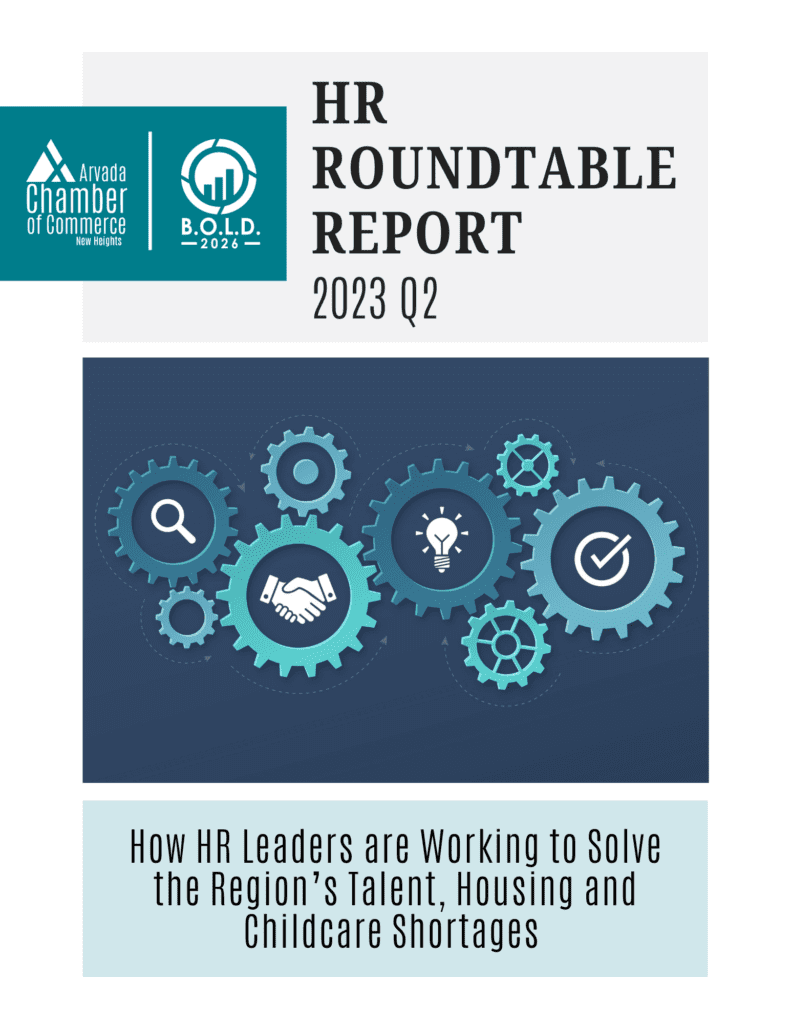How HR Leaders are Working to Solve the Region’s Talent, Housing and Childcare Shortages
The Arvada Chamber of Commerce held three cross-sector roundtable discussions and six interviews with human resources (HR) leaders in Jefferson County this quarter.
The goal was to identify resources and innovative strategies needed to ensure that our region maintains its ability to attract and retain talent, grow the volume of income-aligned housing, ensure quality childcare and ultimately improve our business environment.
These convenings fall under the B.O.L.D 2026 initiative, a five-year regional economic strength and resiliency plan, fueled by a public-private partnership. Findings from this effort reinforce the Chamber’s focus on work-based learning and other career pathways needed to fill employer demand for skilled local talent.
Participating HR leaders shared underlying challenges and solutions with identifying, attracting and retaining talent. The Chamber used these convenings to determine demand for an ongoing cohort that identifies and exposes solutions for all employers to consider. The Chamber thanks all participants for sharing the innovative thinking and approaches they use to solve HR challenges.
Executive Summary
Each roundtable concluded that entry-level talent is the most elusive category to recruit. It’s specifically challenging to identify their skillsets and level of career-readiness. At large, employers feel the need to offer and colorfully communicate a broad range of benefits and culture attributes to attract an applicant pool from which they can sort skills.
Employers also struggle to balance engaging their final candidates throughout hiring and onboarding processes with personal, customized experiences, while setting realistic expectations on career pathways and correlating compensation levels. Curated hiring and onboarding experiences do not guarantee success. Candidates often ghost interviews. New hires have even ghosted start days.
The lack of income-aligned housing concerns primarily manufacturers with local operations, however most employers claim that their local talent pool would be larger if more income-aligned housing existed. Employing non-Jefferson County workers, who can work remotely if allowed to, is currently an essential alternative to hiring locally. Enabling employees to work-from-home (WFH) also helps them manage childcare needs.
Findings
- Worksite context and culture: Post-pandemic, workplace standards expected by both talent and employers have changed. Talent with a desire to work onsite is harder to find. Underlying this challenge are the distances employees must commute to work. As such, employees increasingly work remotely and expect that option. Companies report having a difficult time balancing culture with remote work and hybrid environments.
- Customized benefits: The competition for talent is in the benefits package, and the top benefit workers want is a flexible work environment, to ensure they have flexibility in times of need. One company offered 100% health care coverage. Matching employee needs while maintaining a level of equity across benefit packages are priorities.
- Active recruitment: Some businesses have found success in using multiple platforms and partnerships, such as with headhunters, schools and training programs. Others, mostly small businesses, do not have the capacity and designated support needed to maximize the digital options and dedicated candidate outreach. At large, hiring is more problematic than retention.
- Inspiring performance: Most employers offer a version of work-based learning for upskilling internal employees. Clearly presented career pathways, with correlating compensation levels, improve retention.
- Housing considerations: Organizations have an opportunity to be more aware of employee proximity to work and to provide resources for the housing decisions facing employees.
- Family needs: An interest to better understand the family needs of employees and how benefits could align with these needs was expressed.
Read detailed findings for all below.
Participants
The largest employer has a 20,000-plus headcount; the smallest has 17 employees. Most organizations employ fewer than 100 workers. The breakdown of participants across sectors:
Manufacturers: 4
Not-for-Profits: 6
Financial Institutions: 2
Security Service: 1
Utility Provider: 1
Vehicle Servicer: 1
Industrial Service Provider: 1
Engineering Firm: 1
First Responder: 1
Detailed Findings
Worksite Context and Culture
Post-pandemic, employees have had a bigger say on where they will actually do their work. But this has been particularly challenging for companies that need their workers onsite to do hands-on jobs. When work time is performed fully remotely or split between homes and jobsites, culture can be hard to maintain. Even so, if work from home (WFH) does not affect work productivity or quality, lean in, say several employers.
“More employers should embrace remote work. Culture takes a hit, but culture is never coming back to the pre-pandemic state. It’s safer for people to stay at home.” – financial institution
“We have been utilizing Microsoft Teams and Zoom to stay in constant contact with each other. This has been amazing for retention and when we hired people in 2021, it was a big selling point.” – engineering firm
Employers with fewer than 100 employees offer a family-style culture. If effectively branded and marketed, this personable approach will attract the right talent.
“We work hard to make employees feel like family to us. We get people who appreciate that culture. We make sure that our culture is inclusive and about positive impact.” – security firm
Customized Benefits
Routinely refreshing culture and benefits is needed to draw a greater range of applicants for open roles. A suggested approach: Tie employer ethos or its core business to employee needs.
For example, the security employer gives employees a courtesy security system. They learn how to use the product they install, a co-benefit to the employer. A financial institution in the roundtable offers low-interest rate (below 5%) home loans for its employees and when gas prices surged in 2022 issued $300 gas cards to employees.
During the pandemic, one employer considered offering “Meet the Needs” benefits for employees, such as maid service and hair stylists.
Tuition reimbursement is offered by half of the businesses, but existing and new hires generally do not take advantage of it. Also, about half of the employers take advantage of Section 127 of the Internal Revenue Code, to provide $5,000 in tax-free training benefits such as certifications. Two employers offer $10,000 annual tuition reimbursement programs.
The HR panel also recommended customized and tiered benefits, such as PTO accrual by job level, to recognize and incentivize performance. Some tools used to calibrate compensation by state, industry or job level are Paylocity and Compaas. The most common performance recognition and merit combination: Quarterly check-ins and compensation discussions in an annual review and bonus structure based on company performance.
Active Recruitment
A customized, layered digital approach to recruiting or sourcing talent from various portals is found to be most effective. Job description headlines with keywords that embed employee perks, such as WFH, get more clicks than job title headlines. No combination of keywords is effective indefinitely. Most companies have experimented with digital ads, assisted by a third party.
A suggested approach: Leverage data on trending jobs. For example, apply ADP data to Indeed searches, while using JobTarget to curate talent across job boards.
Another suggested approach: Use headhunters and other niche partners. This is critical when targeting a diverse pool, such as LGBTQ+, veterans, and women, and to curate diverse technical skills that are difficult to summarize and align with trending keywords on job boards.
A final suggested approach for recruitment: Highlight purpose. Increasingly, our HR professionals see a demand to connect employees to their role in solving a societal problem.
Inspiring Performance
Retention ranges from 3% to 30% with these employers. Organizations lacking multiple career pathways are in the 20% – 30% range. Clearly-presented career pathways and inspiring a long-term view on the impact of work helps improve retention.
If attrition occurs with the manufacturers and software employer, it’s often tied to employees frustrated with long product cycles and trial-and-error efforts.
“With new hires, it could take 18 months to see a product cycle from beginning to end.” – manufacturer
“A lot of technologists that stay strong and committed to the process won’t have payoff in 10-20 years. It’s hard when you are in an early-stage space. Fail after fail. People like being where they see the fruits of their labor and it’s hard.” – software firm
A suggested approach: Keep employees focused on problem-solving and execution to engage them for the long run.
“From an engineering standpoint, this is interesting work. Our machine shop is 500 feet away. That’s unique. You get to tinker and troubleshoot onsite, not offshore to another country.” – manufacturer
“We have so many different businesses and products. You can have a career for your whole life with so many different angles.” – software firm
The Compensation Problem
Tiered benefits and compensation, such as paid time off (PTO) accrual by job level, incentivize performance. However, providing this incentive structure to meet talent expectations on compensation is difficult for small businesses. To work around it, some employers are sourcing a wider range of benefits in lieu of the compensation levels requested by talent.
“Trade school grads want to step into main positions with mid-range salaries, but we can’t pay their price, as they are entry level.” – manufacturer
“Wages we offer are not competitive with the living wages in Colorado.” – manufacturer
“A pension and 401k does not help recruit new hires.” – utility provider
“We pay considerably higher wages than the private sector.” – first responder / city service
Housing Considerations
Manufacturers with Jefferson County operations identified a need for more local income-aligned housing to retain their workforce. Organizations using a WFH or fieldwork model that sends workers to meet clients across a broad territory are less concerned with the region’s housing shortage.
Not being able to source workforce housing prevents several manufacturers from recruiting out of state. Only two employers track the proximity of home addresses of target talent to the worksite – and 25 miles is the standard commuting radius.
A suggested approach: Enable transitions to the region and anchor employees locally by bringing in housing specialists. A manufacturer with less than 50 employees customizes relocation packages and hosts snack-and-learn events for first-time home buyers. A software firm with more than 10,000 employees has an onboarding team that finds housing for new hires.
“Employees get housing leads by word of mouth. We are open-minded to a lot of creative solutions.” – utility provider
Another suggested approach: Target neighboring regions where income-aligned housing exists. Two employers target their job searches in metro-Denver counties, outside of Jefferson County, where housing is more aligned to the incomes they offer.
Family Needs
All employers are keen to explore the family needs of employees and target talent to understand how HR benefits align with these needs. Currently, to meet the childcare needs of employees, several businesses offer a work-from-home option.
“We have been focused on a family-friendly environment since 2015, when I bought out my partner. Our policies include flexible hours, remote operation, and 40-hour per year paid volunteer time, so a parent can go to a summer camp or a school trip without having to burn vacation. The biggest requirement we have is communication. If you need to work from 6 am to 3 pm so you can spend time with your kids, let us know, and we will accommodate it. It has allowed the employees to feel that while work is important, work doesn’t take precedence over their needs. This all falls under not treating them like a number, but as a human being who is a valued member of the team.” – engineering firm
A suggested approach: To better align flexible work hours with employee needs, use engagement surveys. No employers have used external measures to evaluate whether their HR policies and culture appeal to employers with family needs.
Another suggested approach: use expert sources. Tap a family support network that sources child solutions.
One last suggested approach: Customize flexible time policies. One employer offers four additional maternity/paternity PTO weeks over the FMLA standard. Employers with less than 50 employees lack hard and fast childcare policies. As such, employees often help each other in sourcing childcare. One company founder will personally take care of employees’ kids on days when brought to work.
“We are really good at being family-friendly. That’s our strength,” this company’s HR representative said. “Employees can bring their baby to work for six months.”
Childcare options in Jefferson County are often not on a bus route – and their hours might not align with work schedules.
“I can’t tell you how many people I’ve turned away because of the daycare hours issue.” – medical manufacturer
Conclusion
Through this HR cohort, the Chamber will routinely solicit feedback on B.O.L.D. 2026 initiatives. In turn, via the Chamber Website’s B.O.L.D. 2026 section HR leaders can find updates on our talent, housing and childcare work. B.O.L.D. updates provided to HR leaders will be customized to detail how to roll out a work-based learning initiative, join a sector partnership, advocate for a housing project, and advance organizational culture and policies.
Talent: www.arvadachamber.org/bold2026-talent
Housing: www.arvadachamber.org/bold2026-housing
Childcare: www.arvadachamber.org/bold2026-childcare
By maintaining a robust feedback loop with the gatekeepers of talent attraction and retention policies, the B.O.L.D. team is better positioned to build out a collaborative ecosystem for attracting and retaining in-demand workers.
Parting thought: Talent, housing and childcare shortages uniquely affect NFPs
Housing and talent shortages facing regional businesses are experienced at heightened levels by not-for-profits (NFP). Internally several local organizations struggle to recruit the talent needed to fulfill external organizational missions around upskilling regional residents and connecting them with income-aligned housing and other mobilizing resources.
Regional humanitarian organizations, participating in our roundtable series, identified the following factors affecting recruitment and retention.
- Below private market rate wages and salaries they offer do not draw an adequate talent pool.
- Job board ads typically highlight candidates’ degrees and certifications, but skills generated by lived experience are more relevant. With one organization, trauma-informed candidates are prioritized.
- Personalizing employee solutions can be problematic if promoting equity is an organizational goal.
To combat these issues, NFPs have prioritized benefits in recruitment efforts, promoted hard-to-fill jobs internally, and focused on mental-health strategies. The Arvada Chamber will continue to support solutions around unique non-profit challenges.









0 Comments